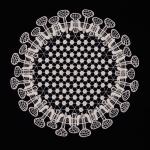Laura Splan
BIOGRAPHY
Laura Splan is a New York based mixed media artist. She holds a Bachelor of Fine Art from the University of California, Irvine where she originally studied Biological Sciences. She received her Master of Fine Art in Sculpture from Mills College in Oakland, CA. Her conceptually driven work employs a variety of materials and processes that usually have a feminine sensibility about them. Unsettling scientific and medical imagery are foiled by more comfortable domestic imagery and craft processes. Likewise, the seemingly familiar and benign are subverted by the anatomical and biological. She often uses her own body in the production of materials for her work such as blood and discarded facial peel. She recently became a certified phlebotomist.
Her southern suburban upbringing in Tennessee nurtured her interest in the visual language of femininity, domesticity, and crafts. She explores that language as one that communicates via façade and designations of beauty and order in relation to the body or to the home. Her interest in science and medicine stems from a variety of experiences and interests. Both her father and sister worked for a company  Doilies (SARS)that manufactures surgical and medical products such as implants. This fostered her interest in medicine and gave her access to images and information she might otherwise not have had. Health epidemics, bio-terrorism, reality makeover shows, Botox parties, anti-microbial products, and pharmaceutical advertising all serve as fuel for inspiration for her work.
Doilies (SARS)that manufactures surgical and medical products such as implants. This fostered her interest in medicine and gave her access to images and information she might otherwise not have had. Health epidemics, bio-terrorism, reality makeover shows, Botox parties, anti-microbial products, and pharmaceutical advertising all serve as fuel for inspiration for her work.
Splan has had solo exhibitions at the International Museum of Surgical Science (Chicago), the New York Hall of Science (NY, NY) and the Richmond Art Center (Richmond, CA). Her work has been included in group exhibitions at the Museum for Arts and Design (NY, NY), the Museum of Contemporary Craft (Portland, OR), and Caren Golden Fine Art (NY, NY). Her work has been featured on Spark* on KQED (San Francisco) and on Eight Forty-Eight on WBEZ (Chicago). She has been a visiting artist and lecturer at Maryland Institute College of Art, California College of Art, Cal Arts, San Francisco Art Institute, Stanford University, San Francisco Camerawork, and the New York Academy of Sciences. She was recently awarded a Jerome Foundation Travel & Study Grant for Visual Arts. Her work is included in the art collection of the University of California San Francisco Infectious Disease Department. Reviews of her work have appeared in Artweek, Discover Magazine, the Village Voice, and Rhizome. Splan’s work has been positioned within a variety of curatorial themes including science, medicine, craft, and feminism.
ARTIST'S STATEMENT
My work explores perceptions of beauty and horror, comfort and discomfort. I use anatomical and medical imagery as a point of departure to explore these dualities and our ambivalence towards the human body. Viruses, blood, and x-rays of bones and viscera can be at once unsetting and enticing. I often combine scientific images and materials with more domestic or familiar ones.  Blood Scarf The ornamentation of wallpaper or the design of a doily lends a sort of relief in its familiarity and pleasing pattern. This juxtaposition creates a response that fluctuates between seduction and repulsion, comfort and alienation. I try to create work that evokes a dichotomous experience with formal imagery that upon closer inspection reveals some uncomfortable truth about our cultural and biological conditions. My work attempts to challenge our constructed responses to these images by triggering a double take in which the viewer re-evaluates their initial perceptions.
Blood Scarf The ornamentation of wallpaper or the design of a doily lends a sort of relief in its familiarity and pleasing pattern. This juxtaposition creates a response that fluctuates between seduction and repulsion, comfort and alienation. I try to create work that evokes a dichotomous experience with formal imagery that upon closer inspection reveals some uncomfortable truth about our cultural and biological conditions. My work attempts to challenge our constructed responses to these images by triggering a double take in which the viewer re-evaluates their initial perceptions.
I am often inspired by the inherent qualities of a material or process. I enjoy the experimentation that goes into the discovery that the consistency of blood facilitates its use as ink or the thickness of vinyl tubing lends itself to being knit into a scarf. Deciphering the narrative implications and poetic possibilities within these qualities is an important part of my practice. I am interested in an exploration into the historical and contemporary meaning that a culture projects onto an object, material, or image as well as in an investigation into its technical attributes. It is often important that the work be reflexive and self-contained -- how not only the form of an object can reveal meaning but also the materials and process by which it was made.